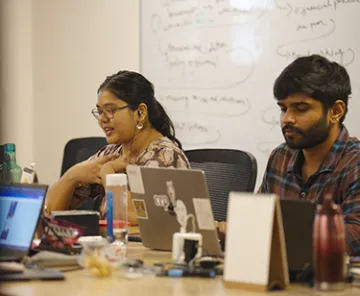Test, Pilot, Scale
General Contractor
The preliminary work of creating a problem statement and ecosystem map and then developing relationships with various partner organizations set the stage for actually rolling out an intervention. The SELCO Foundation went through an extensive process of testing and piloting an intervention in order to learn what did and did not work, before trying to encourage adoption at scale. The extensive roll-out period allowed for redesigning devices to work better in the field, as well as energizing the various elements of the ecosystem.
For rolling out an intervention, SF organized its efforts into two teams, both based in the region of the intervention. The first team was geared towards action research – testing a specific technology, making design changes, and capturing lessons learned. These staffers worked closely with the community organizations, technical enterprises, and end users. They would also work to find specific champions for an intervention, identifying those individuals and organizations that would promote the technology and provide feedback about its strengths and weaknesses. The second team would coordinate with larger, ecosystem-level organizations that would be crucial in bringing an intervention to scale. This team would meet with financial institutions, other potential funders, and the relevant government agencies.
During testing and piloting of new interventions, SF acted much as a general contractor would, making sure that the various actors engaged constructively, forged connections, and provided necessary support. SF became a key hub for feedback from end-users, allowing adjustment to the design or wholesale revision to a given intervention. SF’s coordinator role allowed the Foundation to collect data from multiple locales, letting SF’s teams aggregate the results from numerous iterations of a similar intervention. Maintaining communications among teams, despite the difficulties presented by the terrain, was crucial.
Testing
When a new device seemed ready to be used in the field, prototypes were built and placed with interested microentrepreneurs across a couple of villages. Community partners were crucial in selecting appropriate microenterprises for the test phase. For a useful test, it was important to find potential champions for the new technology. SF needed these first adopters to be willing to experiment and give feedback.
SF provided support to the microenterprises during the test phase, typically bearing 90-100% of the cost of the device and the solar panels. The Foundation reasoned that it did not want poor farmers to take on costs for a technology that was not proven.
During the test period, SF, community partners, and the technical enterprise that provided the device would be in close communication. Any issues with the devices were noted and communicated to the technical enterprise, which in turn would make changes to the devices.
Piloting
After a testing phase during which a device was redesigned as needed, SF would expand the intervention to include more sites and locales. The community organizations and SF chose additional locations to provide a diversity of test conditions. As in the testing phase, SF made sure that user feedback would be given to the technical enterprises. This allowed for further modifications to meet end users’ needs.

Communications between staff members was crucial during the testing and pilot phases.
During this phase of a rollout, SF would pull back on its financing, only supporting 50% of the price of the device. This meant that microentrepreneurs would have to seek financing for the devices, which in turn engaged finance partners.
During the pilot phase, SF oversaw the engagement of other actors in the ecosystem whose long-term support would be needed for successful uptake of the new devices and the related livelihoods. Having a number of artisans take up the device allowed SF and the community partners to assess the capacity building and training requirements needed to advance and support the technology. It also allowed SF to discover whether the technical enterprise or the community partner could find the people to help support the ongoing use of the technology. SF could also assess how the goods or services produced by the new devices fared in the marketplace.
The key, once again, was to find champions for the intervention, especially ones that understood the broader ecosystem. These people could come from any sector – not only users had emerged as champions but also individuals from financial institutions, the government, and from local NGOs. These people would drive the process from inside, lining up other stakeholders, and otherwise building the ecosystem. One SF staffer observes,
The champions are able to take a program much, much further. Our entire approach is based on identifying those champions and empowering them to do what they do best... It goes much faster than investing in people who may not be as open and geared towards a systems approach.
Scaling
While the pilot phase required intense coordination from SF, the scale-up phase meant letting go of the general contractor role and trusting that the new systems in place would support an innovation and allow it to spread. The number of adopters of the new technology could then be an order of magnitude greater than that of the pilot phase.
At this point, SF eliminated its subsidy to microenterprises and relied on the financing schemes that the Foundation had encouraged to provide the necessary capital for adoption. SF continued some oversight, giving close attention to the affordability of devices and looking for ways to reduce costs to microenterprises.
As SF withdrew from supporting an intervention, the hope was that the operating ecosystem would not only sustain the intervention that inspired its creation, but also become a springboard for further innovations. Having aligned microenterprises, financial institutions, and consumer markets, SF believe the energized ecosystem could generate further development without outside intervention. This could take the form of increased production through improved market linkages or by inspiring the production of other goods and services that utilized the same ecosystem participants.